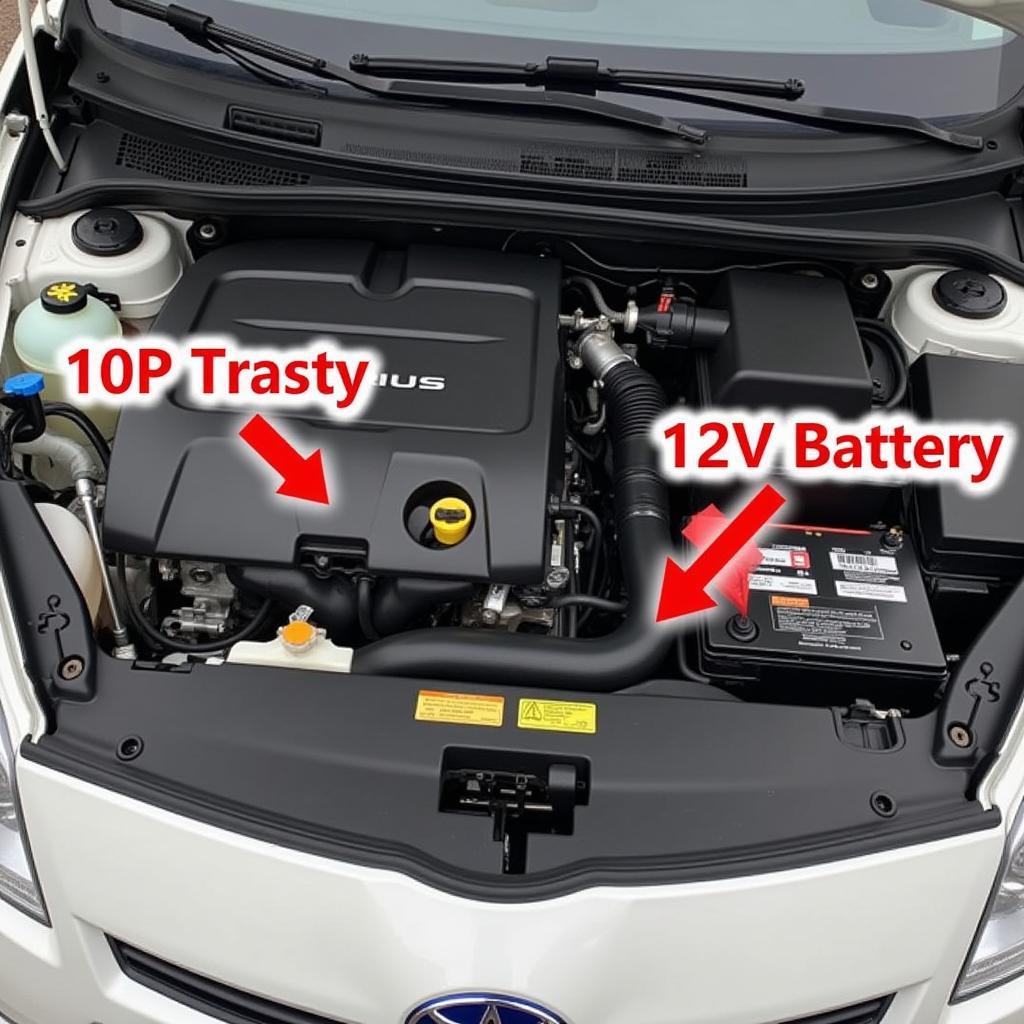Hybrid cars are known for their fuel efficiency and eco-friendliness. However, like any vehicle, their batteries can eventually degrade and show signs of wear and tear. Recognizing bad hybrid battery symptoms is crucial for maintaining your car’s performance and avoiding costly repairs down the road. This guide will equip you with the knowledge to diagnose potential battery issues and take the right steps.
One of the first bad hybrid battery symptoms you might notice is a decrease in fuel economy. As the battery ages, its ability to hold a charge diminishes, forcing the gasoline engine to work harder. This increased reliance on the combustion engine directly impacts your miles per gallon. You might also experience reduced power and acceleration. A failing hybrid battery struggles to provide the necessary boost for electric-powered acceleration, resulting in sluggish performance. If your car seems to be struggling to keep up with traffic or has difficulty accelerating from a stop, it might be time to inspect the battery. Similar issues can arise from a car battery with dead cell.
Identifying the Culprit: Is it Really a Bad Hybrid Battery?
While decreased fuel economy and reduced power can point towards a bad hybrid battery, other factors can mimic these symptoms. For instance, a clogged air filter or worn spark plugs can affect fuel efficiency. Similarly, problems with the transmission or fuel system can impact acceleration. It’s crucial to perform a thorough diagnostic check to pinpoint the source of the issue before assuming it’s the hybrid battery. You can use a diagnostic scanner to read error codes or consult with a qualified mechanic specializing in hybrid vehicles.
Common Bad Hybrid Battery Symptoms
Beyond reduced fuel economy and sluggish acceleration, here are some other common bad hybrid battery symptoms:
- Frequent engine starts and stops: If the gasoline engine cycles on and off more often than usual, even during low-speed driving, it could indicate a weakening battery.
- Fluctuations in the state of charge: Noticeable and erratic changes in the battery’s charge level displayed on the dashboard can signal a problem.
- Strange noises from the battery: Unusual whining, clicking, or buzzing sounds coming from the hybrid battery pack warrant further investigation. These sounds could indicate internal damage or failing components.
- Overheating: An excessively hot battery pack can be a serious sign of a failing battery and should be addressed immediately. Think of it like a car battery overheat situation, but with potentially greater consequences.
What to Do When You Suspect a Bad Hybrid Battery
If you suspect your hybrid battery is failing, seeking professional help is essential. While some minor battery maintenance can be performed at home, working with high-voltage hybrid batteries can be dangerous without proper training and equipment. A qualified technician can accurately diagnose the problem and recommend the appropriate course of action, whether it’s battery reconditioning, module replacement, or a complete battery replacement. They can also provide insights on crv battery issues.
Preventing Hybrid Battery Problems
While hybrid batteries have a limited lifespan, proper care can extend their longevity. Avoid extreme temperatures, as both excessive heat and cold can negatively impact battery performance. Try to maintain a consistent charging routine and avoid letting the battery completely discharge. Regular maintenance checks and adhering to the manufacturer’s recommended service schedule can also help identify potential issues early on. You may also want to learn more about general car battery failing symptoms to be proactive.
“Regularly checking your hybrid battery’s health is like getting regular checkups at the doctor,” says John Smith, a seasoned automotive electrical engineer specializing in hybrid systems. “It helps catch potential issues early and prevent them from escalating into bigger, more expensive problems.”
Conclusion
Recognizing bad hybrid battery symptoms early on can save you money and hassle in the long run. By understanding the common signs of a failing battery and taking proactive steps, you can ensure your hybrid vehicle continues to perform optimally and delivers the fuel efficiency and environmental benefits you expect. Don’t let a bad hybrid battery slow you down. Stay informed, be proactive, and consult with a qualified technician when needed. Remember to check out more about a bad hybrid battery for more information.
FAQ
-
How long do hybrid batteries typically last? Hybrid batteries are designed to last for a significant portion of the vehicle’s life, typically 8-10 years or 100,000-150,000 miles.
-
How much does it cost to replace a hybrid battery? The cost can vary depending on the make and model of your vehicle but generally ranges from $2,000 to $8,000.
-
Can I replace a hybrid battery myself? Working with high-voltage hybrid batteries can be dangerous. It’s recommended to have a qualified technician perform the replacement.
-
Are there warranties on hybrid batteries? Most hybrid batteries come with a warranty, often 8 years/100,000 miles or more. Check your manufacturer’s warranty information.
-
How can I improve my hybrid battery’s lifespan? Avoid extreme temperatures, maintain a consistent charging routine, and follow the manufacturer’s recommended service schedule.
-
What are the signs of a dying hybrid battery? Decreased fuel economy, reduced power, frequent engine starts/stops, fluctuating state of charge, and strange noises are common signs.
-
Can a bad hybrid battery be repaired? In some cases, a failing battery can be reconditioned or have individual modules replaced, which is less expensive than a full replacement.

